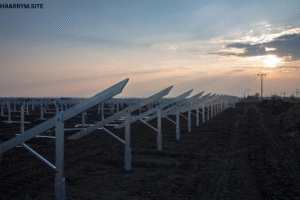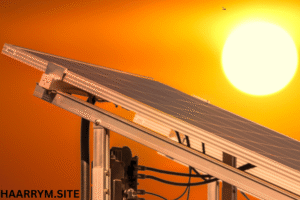Solar energy is becoming a need rather than just a choice in the modern world. Homeowners, companies, and even governments are looking towards sustainable power sources as environmental issues becoming more serious and energy costs climb. The solar energy converter is a basic tool at the core of this green revolution.
But why is a solar energy converter so important and precisely what is it? Everything you need to know—how solar inverters operate, their varieties, advantages, how to pick one, and the newest developments in 2025—will be broken out in this all-encompassing book.
What Is a Solar Energy Inverter?
Most homes and businesses run on alternating current (AC), which is created from direct current (DC) power produced by solar panels using a solar energy converter. Your solar panels are basically worthless in running daily appliances or supplying electricity into the grid without an inverter.
Imagine the inverter in a solar energy system as its brain. It not only changes power but also guarantees maximum energy collection from your solar panels, checks system performance, and regulates voltage.
Why Is the Solar Energy Inverter So Important?
Many people mistakenly believe that solar panels do all the heavy lifting in a solar setup. While panels collect sunlight and convert it into electricity, it’s the inverter that ensures this power is usable.
Here’s what makes the solar inverter a critical component:
-
DC to AC Conversion: Converts solar power into usable energy.
-
Grid Connectivity: Allows power to be sent to the grid or used within your home.
-
Monitoring & Efficiency: Tracks energy production and performance.
-
Safety: Detects electrical faults and shuts down the system if needed.
Without an efficient inverter, even the best solar panels would underperform.
Types of Solar Energy Inverters
Solar inverters come in various types, each suited for specific applications. Understanding the differences will help you choose the right one for your needs.
1. String Inverters
String inverters are the most commonly used type, especially in residential installations.
How it works: Several solar panels are connected in a “string,” and the inverter converts the combined output from all the panels.
Pros:
-
Cost-effective
-
Easy installation
-
Widely available
Cons:
-
Performance depends on the weakest panel
-
Shade or damage on one panel affects the whole string
Best for: Homes with consistent sun exposure and no shading issues.
2. Microinverters
Microinverters are small inverters installed on each individual panel.
How it works: Each solar panel operates independently, and its output is converted at the panel level.
Pros:
-
Maximizes energy harvest
-
Great for shaded or complex rooflines
-
Easy to monitor performance panel-by-panel
Cons:
-
More expensive upfront
-
Slightly more complex to install
Best for: Roofs with partial shading, variable tilt angles, or complex designs.
3. Power Optimizers + Central Inverter
This is a hybrid solution that combines the benefits of microinverters and string inverters.
How it works: Power optimizers are installed on each panel to condition the DC electricity, which is then sent to a centralized inverter.
Pros:
-
Improved energy efficiency
-
Cost-effective compared to microinverters
-
Good for partially shaded systems
Cons:
-
Slightly more complex than standard string setups
Best for: Homeowners wanting balance between performance and cost.
4. Hybrid Inverters
Hybrid inverters can manage energy from solar panels, batteries, and the grid all at once.
How it works: Combines a solar inverter and a battery inverter in one unit, managing inputs and outputs from all sources.
Pros:
-
Ideal for energy storage
-
Smart management of grid vs. battery vs. solar power
-
Future-proof for off-grid systems
Cons:
-
Higher cost
-
More complex system design
Best for: Homes with solar + battery setups or those planning for energy independence.
Key Features to Look for in a Solar Energy Inverter
Choosing the right inverter is just as important as choosing your solar panels. Here are the most important features to consider in 2025:
1. Efficiency Rating
Modern solar inverters have efficiency ratings between 95% and 99%. A higher efficiency means less energy is lost in the conversion process.
2. Monitoring Capability
Look for inverters with built-in or app-based monitoring so you can track energy production, system health, and get alerts for issues.
3. Warranty and Support
A good inverter should have a warranty of 10–25 years, depending on the brand. Make sure there’s accessible customer support and local service centers.
4. Battery Compatibility
If you’re planning on adding battery storage in the future, ensure your inverter supports it—especially if it’s not a hybrid inverter.
5. Smart Grid Ready
With evolving energy regulations, having a “smart grid-ready” inverter ensures compatibility with future grid infrastructure and dynamic pricing systems.
Top Solar Energy Inverter Brands in 2025
Here are some of the most trusted inverter brands that combine performance, reliability, and technological innovation:
-
SMA – German engineering, highly reliable, great for large systems.
-
Enphase – Leading manufacturer of microinverters, ideal for residential setups.
-
SolarEdge – Known for power optimizers and excellent monitoring tools.
-
Fronius – European-made string inverters with top-tier performance.
-
Growatt – Budget-friendly, efficient, and feature-rich.
-
Huawei – High-tech hybrid inverters with advanced smart features.
Always choose an inverter certified and approved for your local grid regulations.
Installation Tips for Maximum Inverter Efficiency
To ensure your solar energy inverter performs optimally:
-
Proper Ventilation – Inverters generate heat. Ensure they’re installed in a cool, shaded, and well-ventilated area.
-
Regular Maintenance – Clean dust and check wires annually to prevent degradation.
-
Professional Installation – Always use a certified solar technician for installation and electrical connections.
-
Orientation and Tilt – While more critical for panels, the inverter should be protected from direct sun and rain.
How to Choose the Best Solar Energy Inverter for Your Needs
When deciding on a solar energy inverter, consider:
-
Your roof structure: Shade? Complex angles? Go for microinverters or optimizers.
-
Your budget: String inverters are cheaper; hybrid and microinverters are more expensive.
-
Future upgrades: Plan to add batteries? Choose a hybrid or battery-ready inverter.
-
System size: Larger systems may need more powerful or multiple inverters.
-
Warranty & Support: Prioritize long warranties and good manufacturer reputation.
Talk with your installer about your energy goals and they can help tailor the best system for you.
Benefits of Using a High-Quality Solar Energy Inverter
Investing in a top-tier inverter pays off in the long run. Here’s how:
1. Maximized Energy Output
Better inverters mean less energy is lost during conversion, which means more usable electricity for you.
2. Greater Reliability
Premium inverters are built to last over a decade with minimal issues.
3. Improved Safety
Modern inverters have advanced fault detection, arc prevention, and automatic shutdown features.
4. Smarter Monitoring
Keep tabs on how much energy your system is producing and get notified if performance dips.
5. Long-Term Savings
Higher efficiency and lower maintenance costs translate to better ROI over time.
Solar Energy Inverter Trends in 2025
The solar industry is rapidly evolving, and inverters are becoming smarter and more integrated. Here are a few trends worth watching:
1. AI & Machine Learning
AI-powered inverters can learn usage patterns and optimize energy distribution between solar, battery, and the grid.
2. Modular Inverters
New models allow you to add or replace modules without changing the entire unit—making them ideal for upgrades.
3. Built-in EV Charging
Some inverters now come with integrated electric vehicle chargers, simplifying home energy systems.
4. Cybersecurity Features
As solar systems connect to smart homes, inverters now include encryption and firewall features to prevent hacking.
5. Grid Services Participation
Many advanced inverters now support virtual power plant (VPP) networks, allowing homeowners to sell excess energy or participate in utility programs.

Conclusion: The Inverter Is the Heart of Solar Energy
Whether you currently have panels installed or are thinking about going solar, the solar energy converter should never be overlooked. Driving the performance, economy, and long-term dependability of your system is its engine.
Selecting the correct kind, making excellent investments, and guaranteeing correct installation will maximise the return on your solar investment and help you to go one step closer to energy independence.
Let your inverter be the clever friend in smartly and effectively controlling the solar electricity in your house as we go towards an energy-conscious future.
